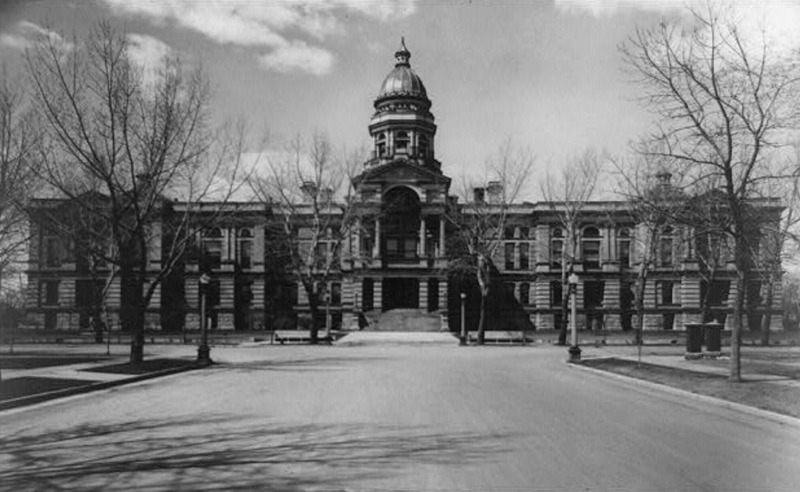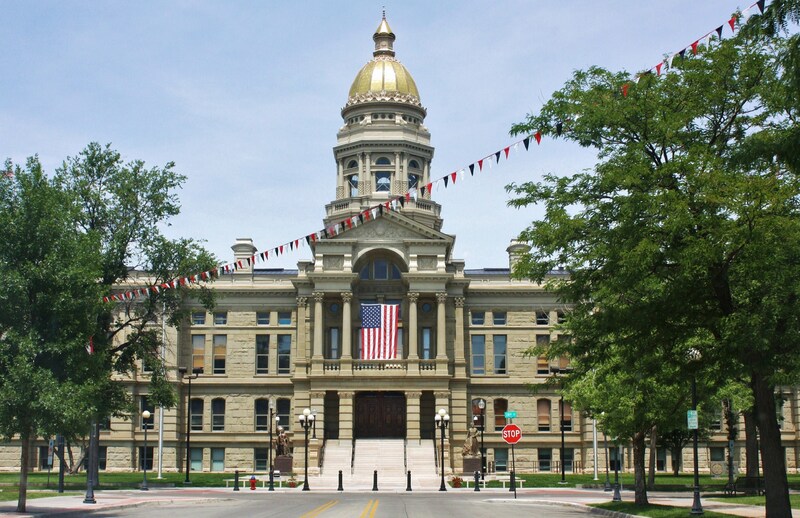Wyoming State Capitol in Cheyenne

The Wyoming State Capitol building is the seat of the Wyoming State Legislature and the Governor’s Office. This modest and comparatively inexpensive Capitol of the smallest U.S. state by population is a working government building and symbol of Wyoming and its past.
The land that became Wyoming was originally the territory of Native peoples. Wyoming’s modern Native tribes include the Ute, Arapaho, Cheyenne, Shoshone, and Crow. The California Trail, Oregon Trail, and Mormon Trail all passed through Wyoming and brought droves of white settlers through the area on their way to the West Coast and Utah the mid-nineteenth century, though few took up residence in the Wyoming area itself. The U.S. Government negotiated the Treaty of Fort Laramie in an effort to protect settlers moving through the area by compensating tribes and building forts. The U.S. Government soon reneged on these treaty obligations and on those of a second Fort Laramie Treaty, causing an escalating cycle of violence. The U.S. Government eventually forced the remaining Native peoples of Wyoming into the reservation system.
Cheyenne began as a stop along the Union Pacific Railroad line in 1867 and quickly surpassed other population centers to become the Territorial Capitol and then State Capitol, as well as Wyoming’s largest city. Ranching, mining, and agriculture continued to draw a trickle of settlers, but the harsh environment, scarce arable land, and temperature extremes restricted the population. Wyoming became its own territory on July 25, 1868 under Andrew Johnson’s presidency and inaugurated its first government May 19, 1869. It achieved statehood July 10, 1890 despite disputes over whether it had achieved the minimum population threshold at that time. In 1886, the Territorial Legislature created a Capitol Commission to organize construction of a capitol building. It chose David W. Gibbs & Co. to design the Capitol and Adam Feick & Bros. to construct it at a bid of only $150,000, worth a little over $4,000,000 in 2020. The Territorial Legislature used the building even before its completion in 1890. By 1915, the State Legislature had outgrown the building and voted to add the House and Senate chambers to the structure, which were completed in 1917.
The Capitol is a Renaissance Revival structure made of both native and Colorado sandstone with a copper dome, which was later gilded in 1900. The interior is finished in marble with a beautiful cherrywood staircase with murals decorating many of the walls. An enormous stuffed bison stands in part of the rotunda, and a bronze bison sculpture stands outside. The bison was a critical part of the diet and culture of the Native people of Wyoming and the intentional near extinction of the animal by white hunters was a severe blow to them. Now, the bison is a symbol of the state and adorns its flag.
In 2016 the Capitol underwent a major renovation which restored decorative elements, added more accessibility with additional elevators and restrooms, and upgraded technology resources. These improvements, completed in 2019, will ensure that the State Capitol building can continue to function as the working seat of government for the people of Wyoming for many years to come.
Images



